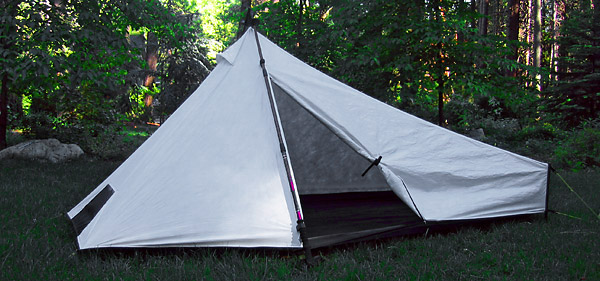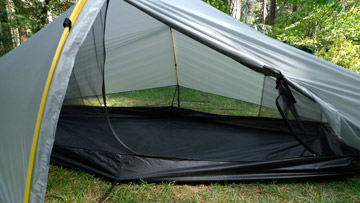Back in February I went camping in the Adirondacks. Several of us were gathered in a tipi one evening discussing the merits (or disadvantages) of certain types of gear we carried. One item that was brought up was the ubiquitous “space blanket.” One member of the group produced a 1-person emergency bivy made by AMK similar to this one:
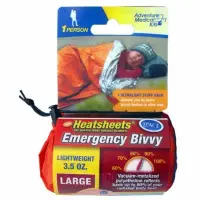
I have used the regular space blanket for wind breaks and shade before, but never in the bivy mode.
So I purchased my own and decided to give it a (limited) test. A few nights ago I gathered up some gear with which to conduct my experiment:
- The emergency bivy
- a small piece of USGI closed cell foam pad (to sit on)
- a notebook and pen(to record the data)
- an Ipod (to pass the time)
- a head lamp (to observe data)
- a couple of key chain thermometers (to collect data)
- a candle lantern and a small bic lighter (to produce heat)
- a Brunton Nomad (mostly for the clock feature)
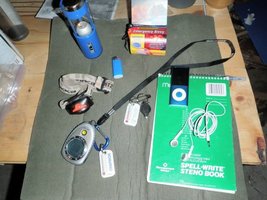
I was dressed in common street clothes (sneakers, blue jeans, cotton shirts) and not the type outdoor garments I’d like to be wearing when facing an unplanned night in the woods.
I walked out into the woods a short distance behind my house. Both of my key chain thermometers read 45*F. I waited there for almost an hour before the nighttime temperature cooled me off enough that I decided to get into the bivy at 10:00pm. It was cold enough for me to put my hands in my pockets and my toes were getting a bit chilly.
To pass the time I was listening to a prerecorded episode of Jack Spirko’s Survival Podcast on my Ipod.
The first thing I noticed once I was inside the bivy was that it wasn’t tall enough to wrap completely around my head. I’m 70” tall and the info on the package said the bivy was 84” long (and 36” wide), but the material did not extend far enough over my head to make a hood. This condition was made worse when I sat down. I had legitimately forgotten to bring a ball cap out with me and now I was concerned that I’d lose enough heat off the top of my head to skew the results.
I sat on the foam pad and leaned up against a tree with my legs crossed Indian style. Things were a little cramped inside the bivy and I was trying to be careful not to tear the material on the ground or rip it apart. After ten minutes in the bivy, I did feel warmer than before and thermometer I brought inside with me read 68*F. My knees were a bit cold where they were in direct contact with the bivy material.
At around 10:30pm, I noticed that my knee had parted the seam on the side. Outside temperature read 43*F, inside temperature 70*. At this time I stretched my legs out in front of me not only to reduce the stress on the seam, but to articulate my sore joints.
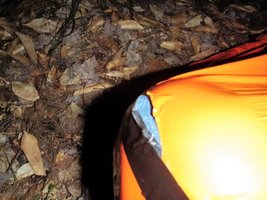
11:00pm – the inside temp measured 68*F, but the thermometer was resting on my lap. From this point on, I kept the inside thermometer suspended inside the bivy with my hands. My feet were cold and so were my knees where they contacted the material. I was shivering a little bit, but nothing more than if you let a chill run down your back.
It was at this time I lit my candle lantern inside the bivy.
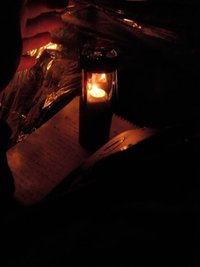
11:15pm – By this time the shivers were gone and the inside temperature read 74*F. To write and take down notes, I needed to hold the shelter closed and hold the lantern with one hand. In the confined space of the bivy it was easy to contact the lantern with the material and burn a hole in it.

By dumb luck I dropped the lantern, but it was caught and hooked on the wire of my spiral notebook. Using my head lamp, I was able to continue note taking; 11:26pm outside temperature 41*F. While writing some notes and trying to shift some weight off my aching joints, I splashed the candle lantern out. I needed to wiggle my torso out of the bivy to locate my lighter. By the time I re lit the lantern and got wrapped back up in the bivy, the inside temperature had dropped to 71*F. This time I used a short piece of stick to suspend the lantern from my knees.
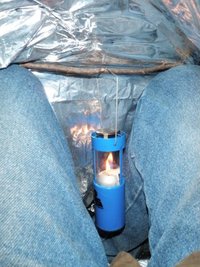
At about this time, the wind came up a bit. I was glad it was to my back and not blowing in my face.
12:00pm - Inside temperature 78*F, outside temperature 41*F. Although the inside temperature was relatively warm, anything below the lantern was cold as well as anything in direct contact with the material. Not being able to stretch out and keep my head covered really made things uncomfortable. I decided to end the experiment. I could have gone longer if I had better clothes on, but I was curious if the bivy would really "reflect" my body heat. I'm not convinced. The bivy did help keep the wind from stealing heat from me and probably would have done the same with any rain had I been able to keep it off my head. My feet never warmed up.
Once I climbed out of the bivy, the wind really gave me the shivers; so much to the point I gave up trying to get the bivy back into its stuff sack. I was really glad I was only 100 yards outside my back door. I quickly got back in the house and made a cup of hot chocolate.
My bivy has reached the end of its service life due to my carelessness and the use of the candle lantern. I'm undecided as to whether or not I'll replace it and carry it with my "unplanned bivouac" gear. This experiment has reinforced my commitment to carrying redundant fire making gear, keeping my navigation skills sharp, and carrying extra clothing even if just going out for the day.

I have used the regular space blanket for wind breaks and shade before, but never in the bivy mode.
So I purchased my own and decided to give it a (limited) test. A few nights ago I gathered up some gear with which to conduct my experiment:
- The emergency bivy
- a small piece of USGI closed cell foam pad (to sit on)
- a notebook and pen(to record the data)
- an Ipod (to pass the time)
- a head lamp (to observe data)
- a couple of key chain thermometers (to collect data)
- a candle lantern and a small bic lighter (to produce heat)
- a Brunton Nomad (mostly for the clock feature)

I was dressed in common street clothes (sneakers, blue jeans, cotton shirts) and not the type outdoor garments I’d like to be wearing when facing an unplanned night in the woods.
I walked out into the woods a short distance behind my house. Both of my key chain thermometers read 45*F. I waited there for almost an hour before the nighttime temperature cooled me off enough that I decided to get into the bivy at 10:00pm. It was cold enough for me to put my hands in my pockets and my toes were getting a bit chilly.
To pass the time I was listening to a prerecorded episode of Jack Spirko’s Survival Podcast on my Ipod.
The first thing I noticed once I was inside the bivy was that it wasn’t tall enough to wrap completely around my head. I’m 70” tall and the info on the package said the bivy was 84” long (and 36” wide), but the material did not extend far enough over my head to make a hood. This condition was made worse when I sat down. I had legitimately forgotten to bring a ball cap out with me and now I was concerned that I’d lose enough heat off the top of my head to skew the results.
I sat on the foam pad and leaned up against a tree with my legs crossed Indian style. Things were a little cramped inside the bivy and I was trying to be careful not to tear the material on the ground or rip it apart. After ten minutes in the bivy, I did feel warmer than before and thermometer I brought inside with me read 68*F. My knees were a bit cold where they were in direct contact with the bivy material.
At around 10:30pm, I noticed that my knee had parted the seam on the side. Outside temperature read 43*F, inside temperature 70*. At this time I stretched my legs out in front of me not only to reduce the stress on the seam, but to articulate my sore joints.

11:00pm – the inside temp measured 68*F, but the thermometer was resting on my lap. From this point on, I kept the inside thermometer suspended inside the bivy with my hands. My feet were cold and so were my knees where they contacted the material. I was shivering a little bit, but nothing more than if you let a chill run down your back.
It was at this time I lit my candle lantern inside the bivy.

11:15pm – By this time the shivers were gone and the inside temperature read 74*F. To write and take down notes, I needed to hold the shelter closed and hold the lantern with one hand. In the confined space of the bivy it was easy to contact the lantern with the material and burn a hole in it.

By dumb luck I dropped the lantern, but it was caught and hooked on the wire of my spiral notebook. Using my head lamp, I was able to continue note taking; 11:26pm outside temperature 41*F. While writing some notes and trying to shift some weight off my aching joints, I splashed the candle lantern out. I needed to wiggle my torso out of the bivy to locate my lighter. By the time I re lit the lantern and got wrapped back up in the bivy, the inside temperature had dropped to 71*F. This time I used a short piece of stick to suspend the lantern from my knees.

At about this time, the wind came up a bit. I was glad it was to my back and not blowing in my face.
12:00pm - Inside temperature 78*F, outside temperature 41*F. Although the inside temperature was relatively warm, anything below the lantern was cold as well as anything in direct contact with the material. Not being able to stretch out and keep my head covered really made things uncomfortable. I decided to end the experiment. I could have gone longer if I had better clothes on, but I was curious if the bivy would really "reflect" my body heat. I'm not convinced. The bivy did help keep the wind from stealing heat from me and probably would have done the same with any rain had I been able to keep it off my head. My feet never warmed up.
Once I climbed out of the bivy, the wind really gave me the shivers; so much to the point I gave up trying to get the bivy back into its stuff sack. I was really glad I was only 100 yards outside my back door. I quickly got back in the house and made a cup of hot chocolate.
My bivy has reached the end of its service life due to my carelessness and the use of the candle lantern. I'm undecided as to whether or not I'll replace it and carry it with my "unplanned bivouac" gear. This experiment has reinforced my commitment to carrying redundant fire making gear, keeping my navigation skills sharp, and carrying extra clothing even if just going out for the day.
Last edited:


![Wink [wink] [wink]](/xen/styles/default/xenforo/smilies.vb/002.gif)
![Laugh [laugh] [laugh]](/xen/styles/default/xenforo/smilies.vb/012.gif) ask me how i know
ask me how i know
![Thinking [thinking] [thinking]](/xen/styles/default/xenforo/smilies.vb/010.gif)


